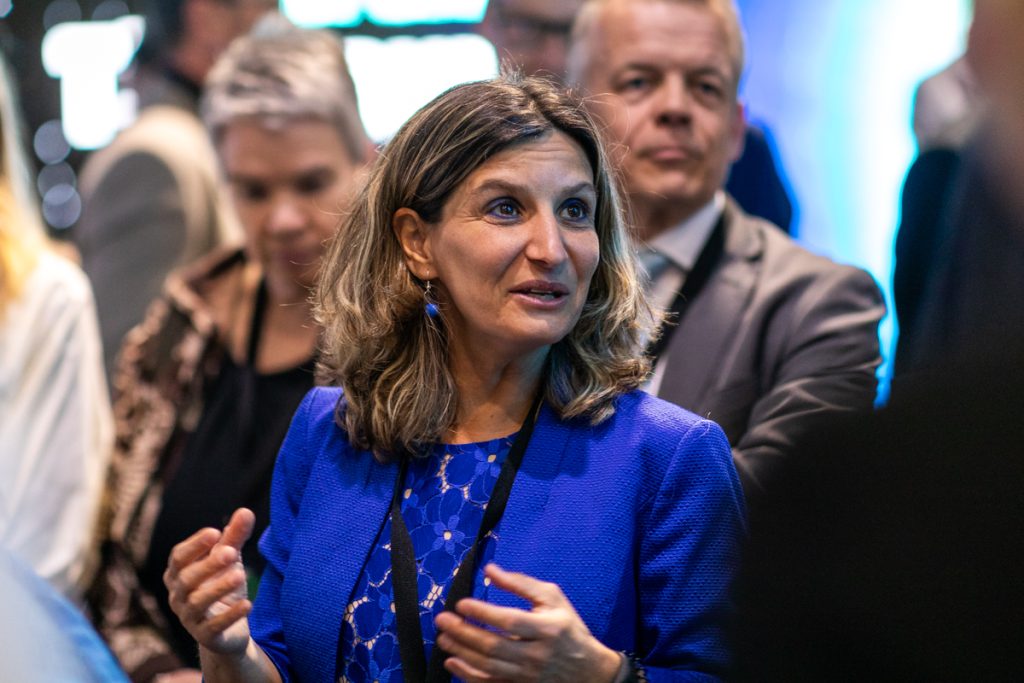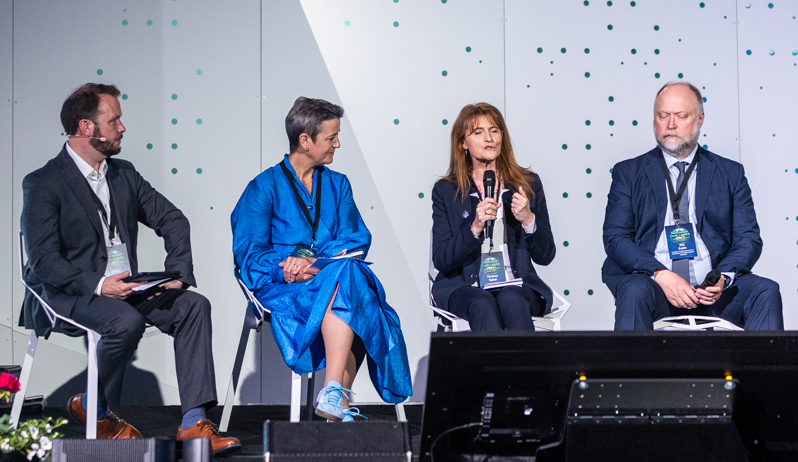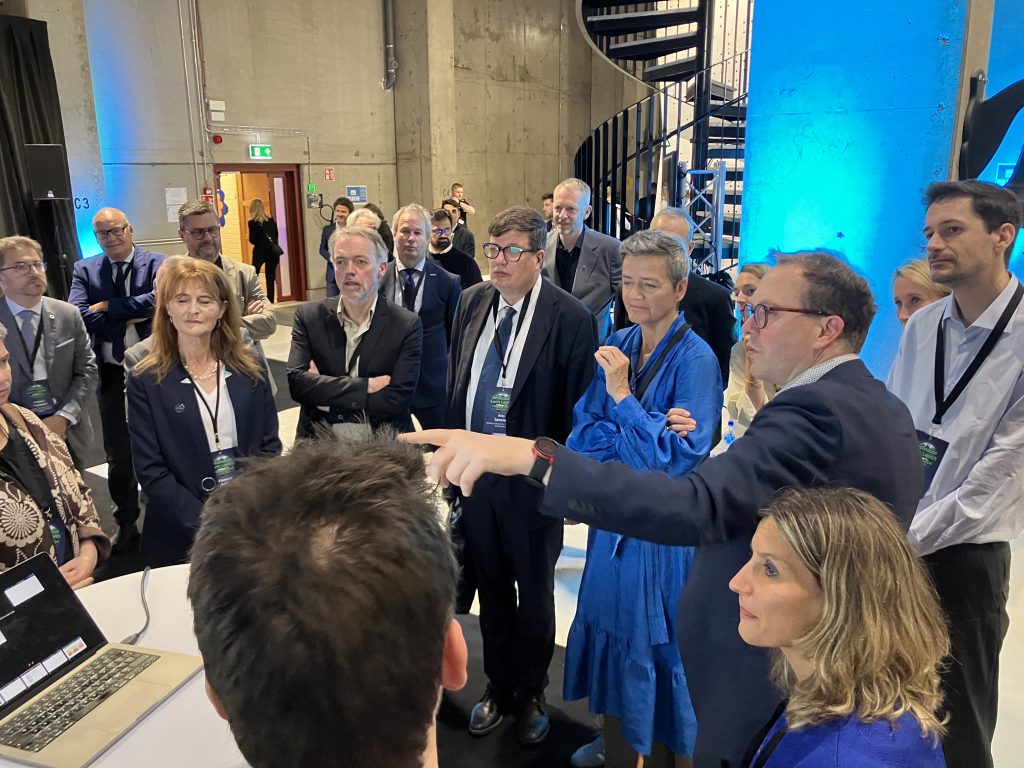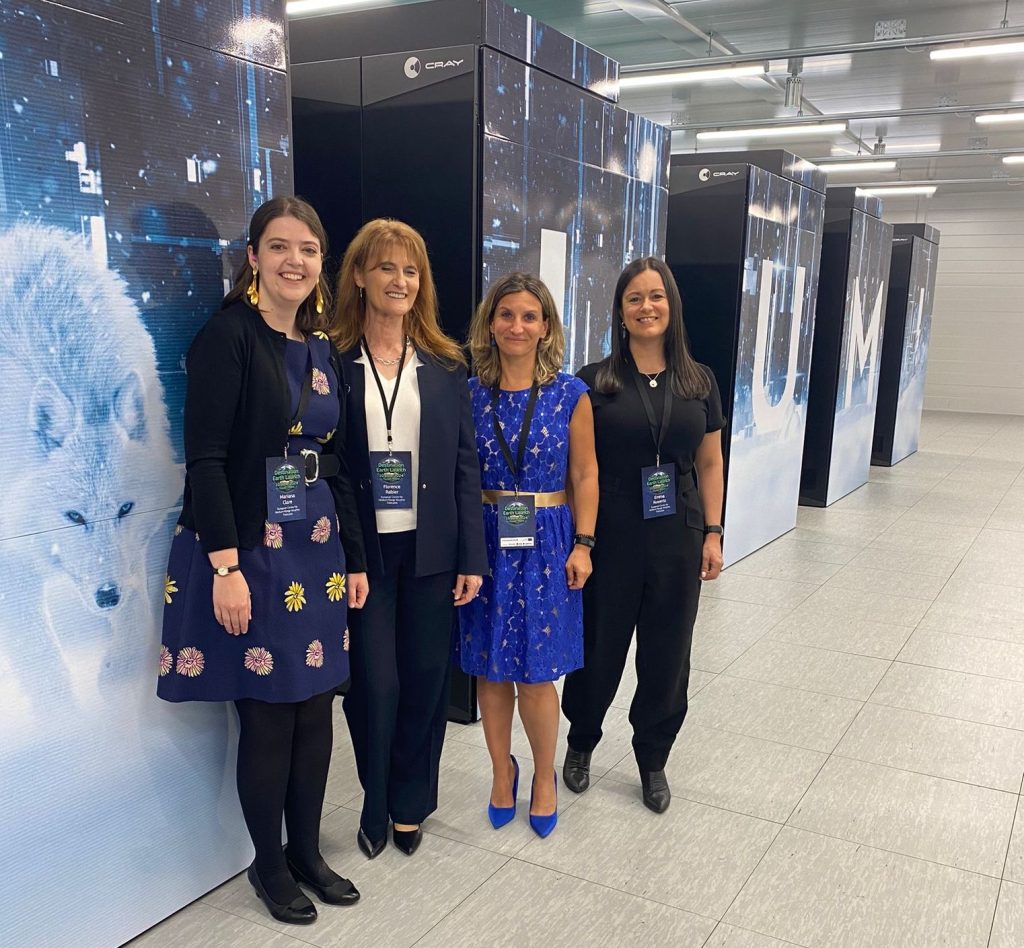The European Commission launched the Destination Earth system from the LUMI supercomputer centre in Kajaani, Finland. The high-level event on 10 June 2024 marked the start of Phase II of Destination Earth, the ambitious initiative of the European Union to create a digital replica of the Earth system. The European Commission Executive Vice-President for a Europe Fit for the Digital Age Margrethe Vestager led the ceremony that gathered representatives of the European Commission, key stakeholders of the initiative and the three implementing entities (the European Centre for Medium-range Forecasts – ECMWF, the European Space Agency – ESA, and the European Organisation for the Exploitation of Meteorological Satellites – EUMETSAT).
ECMWF was represented by a strong delegation in the event to unveil the progress made in developing the first two high-priority digital twins and the Digital Twin Engine. Director-General of ECMWF Florence Rabier, Deputy Director General, Florian Pappenberger and Irina Sandu, Director for Destination Earth at ECMWF, as well as a number of key scientists involved in the initiative, were present in Kajaani to share the latest developments in the system and explain how the DestinE system works to the participants and those who followed the event online.
Watch the live streaming replay
Two years and a half after the launch of the initiative, ECMWF together with some 90 institutions from across Europe, has implemented the Digital Twin Engine and the first two high-priority digital twins on Climate Change Adaptation and Weather-induced Extremes.
“It has been two and a half very busy years for all the teams involved, inside ECMWF and for the partners outside working closely with us to deliver the system. Everyone has done an amazing job to succeed during this implementation phase. We are very happy to enter this new phase in which we will integrate new elements of artificial intelligence and machine learning, and of course will continue to work on our digital twins and the underpinning high-resolution simulations, which are already producing exciting results.” said Irina Sandu.

Margrethe Vestager, the managing Director of Finland’s CSC-IT Center for Science Kimmo Koski, and the Finnish Minister of Employment, Arto Satonen welcomed the participants to the event before a panel to discuss the implementation of DestinE to the date of the launch event.
Less than a week after the United Nations Secretary-General Antonio Guterres gave a special address partly based on data provided by the Copernicus Climate Change Service, implemented by ECMWF, Director-General Florence Rabier highlighted the value of improved climate and weather information.
“In our time of climate crisis, Destination Earth is a groundbreaking initiative to benefit society. For fifty years ECMWF in collaboration with its Member States has been at the cutting edge of using high-performance computers together with large Earth Observation data, modelling and now artificial intelligence to create value for society through weather forecasting and climate. We are proud to utilise this expertise in creating the first digital twins of DestinE.”

Deputy Director-General of the EU Commission’s DG CNECT Thomas Skordas and Director-General of Eumetsat Phil Evans completed the panel, with a video message from ESA Director-General Josef Aschbacher and the contribution of Director of Earth Observation Programmes Simonetta Cheli that connected remotely with the panel.
The launch ceremony consisted of Margrethe Vestager ringing the bell of the LUMI supercomputing center, a symbol of the past of the data center building as one of the largest paper mills in Europe, that today hosts Europe’s most powerful supercomputer.

ECMWF scientist Sebastien Milinski introduced the audience to the features and progress of the Climate Change Adaptation Digital Twin to Margrethe Vestager together with scientists from the Barcelona Supercomputing Center (BSC), also involved in developing the Climate Change Adaptation Digital Twin, and the ECMWF delegation in a dedicated booth. Participants could exchange with the scientists involved in DestinE all along the event.
Welcome to the future – Destination Earth unveiled
A second panel gathered representatives from the Barcelona Supercomputing Center (BSC), the European Environmental Agency (EEA) and the Danish Meteorological Institute (DMI). Francisco Doblas, head of the Earth Sciences Department at the BSC, Karl Hamilton, Head of Data and Information Services Programme of the EEA, and Marianne Thyrring, Director, Danish Meteorological Institute, discussed the novelties of the DestinE system and how it can bring added value with respect to existing capabilities. Partners involved in the development of digital twins also shared their views on the future use of DestinE digital twins via video messages.

The DestinE launch event concluded with a discussion led by Margrethe Vestager in which ECMWF scientist Mariana Clare and other early career scientists discussed the latest breakthroughs in machine learning and artificial intelligence in weather forecasting and Earth system modelling sciences.
Clare highlighted how these breakthroughs in ML/AI can boost the Destine system, supporting in particular the quantification of uncertainties in the simulations and increasing its interactivity. She also emphasised that a key aspect to ensure that society benefits from AI research is developing an ethical, trustworthy AI. “Without this it will be difficult to have sustainable developments of models that benefit society,” said Mariana Clare.
From now on, visitors to the DestinE platform will have a glimpse into features demonstrating some of the future capabilities of the system. In the near future, selected groups of users will be given access to advanced services and datasets for testing, improving and further developing the system towards its operationalisation.

Role of ECMWF in Destination Earth
ECMWF is in charge of developing the first two high-priority digital twins and the Digital Twin Engine.
The Climate Change Adaptation Digital Twin is being implemented in close cooperation with ECMWF by a consortium led by CSC-IT Center for Science. This first attempt of operationalising multi-decadal climate simulations will provide bespoke, globally consistent Earth system information at scales of a few kilometers, where the impacts of climate change are felt. The update frequency of cycles of climate projections will be reduced from 7-10 years to yearly or less.
The Weather Induced Extremes Digital Twin produces bespoke cutting-edge numerical simulations of extreme events on a timescale of a few days ahead to support decision-makers to respond rapidly to meteorological, hydrological and air quality extremes. It consists of a global component being developed by ECMWF and a regional component being developed by a strong partnership led by Météo France. While the global component will run on a regular basis, the regional one will be activated on demand to zoom on extreme events affecting Europe.
The Digital Twin Engine is the advanced software environment developed by ECMWF togeher with its partners to enable the deployment of Destination Earth in the supercomputer systems provided by EuroHPC Joint Undertaking, as well as the complex operations of the digital twins, including data handling of the extremely large datasets generated and machine learning.
Destination Earth is a European Union-funded initiative launched in 2022, with the aim to build a digital replica of the Earth system by 2030. The initiative is being jointly implemented under the leadership of the EU Commission’s DG CNECT by three entrusted entities: the European Centre for Medium-Range Weather Forecasts (ECMWF), responsible for the creation of the first two ‘digital twins’ and the ‘Digital Twin Engine’, the European Space Agency (ESA) responsible for building the ‘Core Service Platform’, and the European Organisation for the Exploitation of Meteorological Satellites (EUMETSAT), responsible for the creation of the ‘Data Lake’.
We acknowledge the EuroHPC Joint Undertaking for awarding this project strategic access to the EuroHPC supercomputers LUMI, hosted by CSC (Finland), and the LUMI consortium, Marenostrum5, hosted by BSC (Spain) Leonardo, hosted by Cineca (Italy) and MeluXina, hosted by LuxProvide (Luxembourg) through a EuroHPC Special Access call.
More information about Destination Earth is on the Destination Earth website and the EU Commission website.
For more information about ECMWF’s role visit ecmwf.int/DestinE
For any questions related to the role of ECMWF in Destination Earth, please use the following email links:
